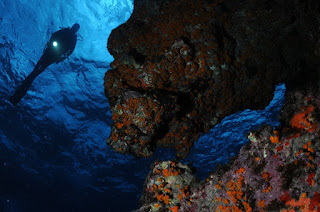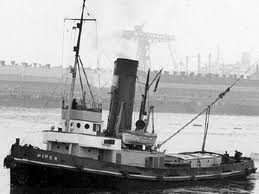The History of diving goes back to the time when man learned to swim!
People have been diving underwater throughout the ages, probably for as
long as people have been swimming… Starting out breath holding from time to time man would evolve to what we know today as scuba!
There are records, in some cases stories more than myth, of the methods used and what was done while diving!
 |
| Pearl Divers. |
One historical note is where Alexander the Great used a wooden
barrel as a diving bell to clear a harbour in 332 B.C.
The main reasons for people to have started diving at first would
have been for food, pearl diving, sponges and shells. The desire to swim
underwater for various reasons must have existed for as long as Mankind
has swum. Pearl diving is still practiced today in some locations in
much the same way as they did in the beginnings of the history of scuba
in all its various forms.
In very early times the methods used, such as hollow reeds and
inflated bags of air were largely limiting, both in terms of depth as
well as the time this allowed the swimmer to stay underwater.
Divers, pearl diving, used a stone hooked by a rope onto the divers
foot which he would then unhook when he needed to return to the surface.
It is said dives of up to 40 meters would be normal!!!
Surely life expectancy would have been fairly short!
This method carried on being used in various parts of the world until
relatively recently.
There is a scuba diving history record from the Ming Dynasty in
China that divers were able to stay underwater for prolonged periods of
time by way of a long curving pipe that led up above the surface of the
water. This long breathing tube was strengthened by rings of silver and
fastened to a mask attached to the face.
A lot of the development of diving, like many other advances in
technology have been as a result of the demands of war and the need for
salvage operations by Naval units.
In Europe in the 1500’s leather diving suits were used, combined with
air from manual pumps to depths of 25 meters.
This progressed over the next two hundred years until the well known
steel and brass diving helmet with rubber suits were being used, for
extensive dives to undertake commercial salvage underwater to extreme depths.
Research carried out by Paul Bert and John Scott Haldane helped explain
the effects of water pressure on the human body and in turn defining the
limits involved in compressed air diving.
There were technological advances in terms of pumps and other equipment
which allowed people to stay under water longer as well.

The first Scuba apparatus to be developed in scuba diving history was
invented by Benoit Rouquayrol and Auguste Denayrouse, which included a
diving helmet, a compressed air tank and an early rudimentary demand
regulator. This is a very early version of what was later developed into
modern day Scuba equipment used for modern Scuba dive sports.
The first studies of decompression sickness were reported in the 1870’s
by Dr Andrew H Smith who did not report any knowledge of the effect of
Nitrogen Bubbles forming in the blood.
Paul Bert made this connection in 1878 and made the first proposals in
scuba diving history, that treatment should be by recompression of the
diver.
John Scott Haldane through his research in 1908 compiled the first dive
tables used to avoid the ‘bends’ as decompression sickness became known.
In 1917, The United States Navy began using the Mark V Diving Helmet
for all of its underwater salvage work, using a largely unchanged design
well into the 1980’s.
In the 1930’s, Fins and masks were developed out of rubber and glass
(for the masks!)


When talking of the History of Scuba the name
Jacques Cousteau is synonomous.
Jacques Cousteau and Emile Gagnan made the next significant step
taking the development of Scuba to the point where it became accessible
to the masses. In 1943 they developed the demand regulator similar in
principle to that developed by Rouquayrol-Denayrous.

From this point on Scuba steadily developed in the years to follow,
becoming hugely popular as a result of a television programme starring
Lloyd Bridges – The Sea Hunter, this inspired thousands to take up the
sport. It is amazing that a television show could have such an important
role in the history of scuba.
The increase in accidents as the sport became more and more popular
prompted the forming of PADI in 1966 to train and
certify divers. Imagine how dangerous the sport was without the
regulated training to ensuring people knew where the dangers lay?

By the late1970’s the equipment used, such as Buoyancy Control Devices,
pressure gauges and single hose regulators became the norm as did dive
computers in the 1980’s (what a relief!)
By 2016 certified over 25,000,000 divers Globaly, there are many other organizastions out there as well CMAS / RAID / SSI and the list goes on.
Even scuba diving is still evolving to the point divers are using
Re-Breathers, so the can stay longer as the units do not emit bubbles
like normal scuba when you exhale, these elite units recycle your air
and add small amount of oxygen to the loop to give you the best mix for
that part of the dive!
Today where have we reached we have seen pearl divers and spearfishing used over the century to supply food and money 100 years on we have wet bells for diving then pressurized suits, to hard hat diving and now scuba regulators and options of suits and BCD's.
Today's dive school can offer a vast vaiaty of set up and diving from single tank to twin set or side mount diving and move your way along to re-breather where time is not the major factor! but thats for another time!












 The first Scuba apparatus to be developed in scuba diving history was
invented by Benoit Rouquayrol and Auguste Denayrouse, which included a
diving helmet, a compressed air tank and an early rudimentary demand
regulator. This is a very early version of what was later developed into
modern day Scuba equipment used for modern Scuba dive sports.
The first Scuba apparatus to be developed in scuba diving history was
invented by Benoit Rouquayrol and Auguste Denayrouse, which included a
diving helmet, a compressed air tank and an early rudimentary demand
regulator. This is a very early version of what was later developed into
modern day Scuba equipment used for modern Scuba dive sports.























